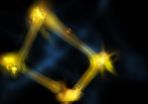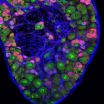(Press-News.org) Scientists have uncovered clues as to how our genomes became riddled with viruses. The study, supported by the Wellcome Trust, reveals important information about the so–called 'dark matter' of our genome.
For years scientists have been struggling with the enigma that more than 90 percent of every mammal's genome has no known function. A part of this 'dark matter' of genetic material is known to harbour pieces of DNA from ancient viruses that infected our ancestors going back as far as the age of the dinosaurs.
Researchers at Oxford University, the Aaron Diamond AIDS Research Center in New York and the Rega Institute in Belgium wanted to know how these ancient viruses got into their hosts' genomes in such abundance.
The team searched the genomes of 38 mammals covering a large range of species: from mouse, rat and bat to human, elephant and dolphin. Genetic material from all of the residing viruses was collected and then compared using mathematical models.
The findings revealed that one particular group of viruses had lost the ability to infect new cells. Their genetic material is still able to amplify itself but the whole lifecycle of the virus is passed within a single cell. This change, they found, was followed by a dramatic proliferation of the virus' genetic material within the genomes.
A comparison with all of the other viruses in the genomes revealed this to be a universal phenomenon, and that loss of cell infectivity is associated with a roughly 30-fold increase in the abundance of the virus.
The pattern resembles that which we see during epidemic outbreaks, whereby a small proportion of infected people are often responsible for most of the spread of an infectious agent to the rest of the population. They are described as 'superspreaders'.
According to the lead author, Dr Gkikas Magiorkinis from Oxford University's Zoology Department: "We know that much of the 'dark matter' in our genome plays by its own rules, in the same way as an epidemic in an infectious disease, but operating over millions of years."
Robert Belshaw from the same department, who led the study, goes on to explain: "We suspect that these viruses are forced to make a choice: either to keep their 'viral' essence and spread between animals and species, or to commit to one genome and then spread massively within it. This is the story of the epidemic within every animal's genome, a story which has been going on for 100 million years and which continues today."
### The findings are published today in the journal Proceedings of the National Academy of Sciences.
Study reveals how ancient viruses became genomic 'superspreaders'
2012-04-24
ELSE PRESS RELEASES FROM THIS DATE:
Olympic boxing may damage the brain
2012-04-24
Olympic boxers can exhibit changes in brain fluids after bouts, which indicates nerve cell damage. This is shown in a study of 30 top-level Swedish boxers that was conducted at the Sahlgrenska Academy at the University of Gothenburg, Sweden, in collaboration with the Swedish Boxing Federation, published in PLoS ONE.
It has been debated for quite some time whether Olympic boxing (amateur boxing) is hazardous to the brain. Researchers at the Sahlgrenska Academy, Gothenburg University, joined with colleagues at the Faculty of Health Sciences at Linköping University and ...
Scientists have discovered genes that increase the risk of osteoporosis and fractures
2012-04-24
Researchers at the Sahlgrenska Academy at the University of Gothenburg, Sweden, have identified the genetic variations that are believed to cause osteoporosis. The study, published in Nature Genetics and involving leading researchers from Sweden and the world, shows among other interesting facts that women with a higher proportion of genetic variations associated with osteoporosis have a more than 50 percent increased fracture risk.
Osteoporosis is a common and a devastating age-related disease about 50 percent of all who have a hip fracture after age 80 die within one ...
2 distinguishable gene groups detected: 1 'normal' and 1 problematic
2012-04-24
Jerusalem, April 23, 2012 – Researchers at the Hebrew University of Jerusalem and other institutions have identified two distinguishable groups of genes: those that produce very abundant biochemical products in the cell and function properly in the majority of biological processes, and a flexible subset that might have abnormal function in a disease.
They demonstrated that these two groups can be found among various organisms and cell types, including stem cells and cancer cells.
One set of genes is a robust network that conducts the basic functions of all cells, ...
Study shows that, in restaurants, race matters
2012-04-24
A new study from North Carolina State University shows that more than one-third of restaurant servers discriminate against African-American customers.
"Many people believe that race is no longer a significant issue in the United States," says Sarah Rusche, a Ph.D. candidate in sociology at NC State and co-author of a paper describing the study. "But the fact that a third of servers admit to varying their quality of service based on customers' race, often giving African-Americans inferior service, shows that race continues to be an issue in our society."
Researchers ...
Quantum physics mimics spooky action into the past
2012-04-24
This press release is available in German.
Physicists of the group of Prof. Anton Zeilinger at the Institute for Quantum Optics and Quantum Information (IQOQI), the University of Vienna, and the Vienna Center for Quantum Science and Technology (VCQ) have, for the first time, demonstrated in an experiment that the decision whether two particles were in an entangled or in a separable quantum state can be made even after these particles have been measured and may no longer exist. Their results will be published this week in the journal "Nature Physics".
Entangled ...
Fish larvae find the reef by orienting: The earlier the better
2012-04-24
MIAMI – The behavior of marine larvae is central to fully understanding and modeling the pelagic (open ocean) stage for many coastal organisms. For the first time, a numerical study conducted by the University of Miami (UM) incorporates horizontal larval fish navigation skills into realistic 3D flow fields, creating a powerful tool that spells out how larvae use environmental cues to find their way back to the reef after being out on the open ocean. The new model uses reliable larval swimming speeds and vertical migration, known life history traits and spawning time to ...
Collaborative research examines executive turnover in federal workplaces
2012-04-24
A research partnership represented by the University of Cincinnati, Cincinnati Children's Hospital Medical Center and the Veterans Health Administration (VHA) National Center for Organization Development (NCOD) is examining factors predicting the turnover of senior executives in the federal workplace. It's an area that has not been widely researched, yet it can result in a costly toll on organizations – both financially in replacing senior staff as well as professionally in the loss of the knowledge, skills and strategy-building talent of senior-level management. The project ...
Pain relief with PAP injections may last 100 times longer than a traditional acupuncture treatment
2012-04-24
CHAPEL HILL, N.C. – Scientists at the University of North Carolina at Chapel Hill have identified a new way to deliver long-lasting pain relief through an ancient medical practice.
In an article published in the April 23 online edition of Molecular Pain, UNC researchers describe how exploiting the molecular mechanism behind acupuncture resulted in six-day pain relief in animal models. They call this new therapeutic approach PAPupuncture.
Principal investigator Mark J. Zylka, PhD, associate professor in the Department of Cell and Molecular Physiology and the UNC ...
Vitamin E in diet protects against many cancers
2012-04-24
Next time you need to choose between vegetable oil and margarine in that favorite recipe, think about your health and reach for the oil.
While the question of whether vitamin E prevents or promotes cancer has been widely debated in scientific journals and in the news media, scientists at the Center for Cancer Prevention Research, at Rutgers Mario School of Pharmacy, and the Cancer Institute of New Jersey, believe that two forms of vitamin E – gamma and delta-tocopherols – found in soybean, canola and corn oils as well as nuts do prevent colon, lung, breast and prostate ...
Carnegie Mellon fluorescent biosensor reveals mechanism critical to immune system amplification
2012-04-24
PITTSBURGH—Using a new fluorescent biosensor they developed, researchers at Carnegie Mellon University have discovered how a key set of immune cells exchange information during their coordinated assault on invading pathogens. The immune cells, called dendritic cells, are harnessed by cancer vaccines and other therapeutics used to amplify the immune system. The finding, published online March 29 in the journal Angewandte Chemie, marks the first time that scientists have visualized how antigens are transferred in the immune system between dendritic cells.
"Knowing the ...




